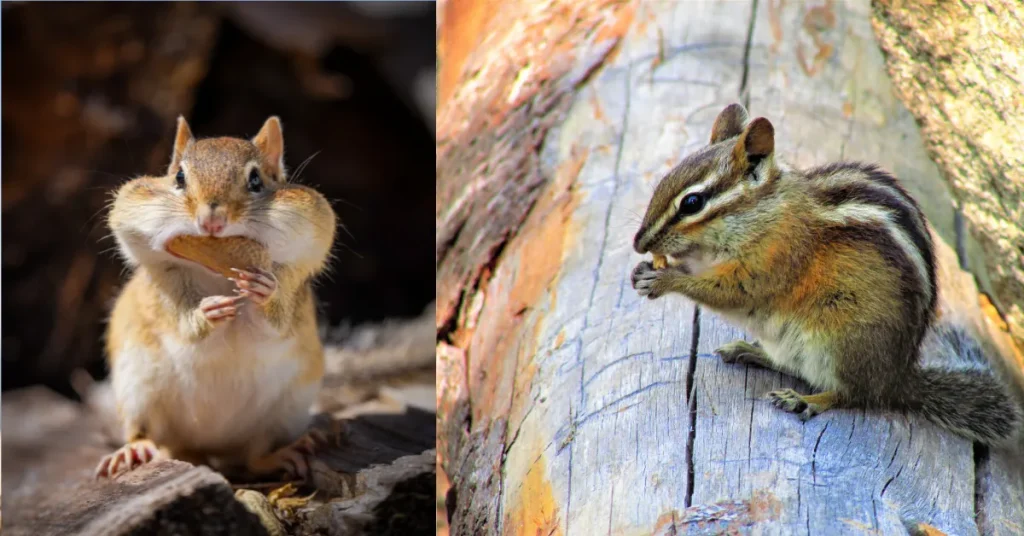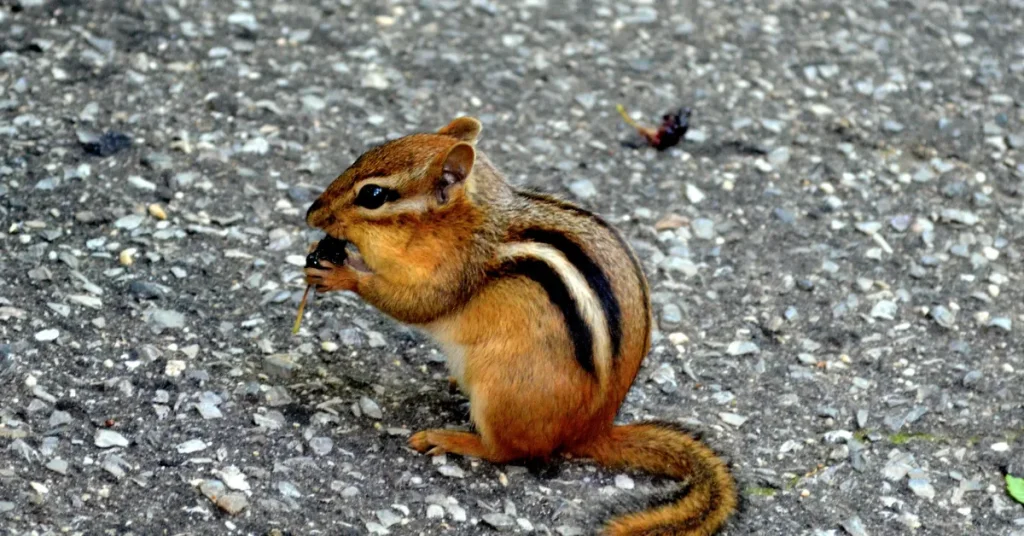Chipmunks typically burrow between 2 to 3 feet deep underground. These burrows can extend up to 30 feet in length.
Chipmunks are small, industrious creatures that create extensive burrow systems to serve as their homes and larders. These burrows, often featuring several entrances, provide chipmunks with safety from predators and harsh weather.
Inside, the burrows contain various chambers for sleeping, rearing young, and storing food.
Considering their size, chipmunks’ ability to excavate such elaborate and expansive underground habitats is a remarkable demonstration of their engineering skills.
Gardeners and homeowners might sometimes regard them as pests, yet these burrows play a role in soil aeration and nutrient cycling.
The intricate tunneling behavior of chipmunks showcases the complexity and adaptability of these small mammals to their environments.

The Hidden World Of Chipmunks
Welcome to the hidden world of chipmunks, an underground realm few ever witness. These small, agile critters spend much of their lives beneath the surface. Let’s dig deeper to uncover the secrets of their subterranean lifestyles.
Subterranean Lifestyles
Chipmunks burrow not just to escape predators. These tunnels provide a cool place during hot days and warmth during winter. Their burrows are quite the architectural feat, with chambers for sleeping, storage, and even waste.
Most species create burrows that start with a single entrance hole. This hole can lead to tunnels as long as 30 feet. Some burrows extend up to 3 feet underground.
- Entrance hole: often hidden under rocks or logs
- Sleeping quarters: lined with leaves for comfort
- Food storage: keeps nuts and seeds safe and dry
The Diversity In Burrowing Behavior
Not all chipmunks dig to the same depth or create similar burrow systems. Their behavior varies by species and habitat.
| Species | Location | Depth of Burrow |
| Eastern Chipmunk | Wooded areas, gardens | Up to 3 feet |
| Western Chipmunk | Rocky regions, bushy terrains | Varies greatly |
| Least Chipmunk | High altitudes, open forests | Less than 3 feet |
Some species even alter their burrows with the changing seasons. These adaptable creatures make changes to survive and thrive.
Architects In Miniature

When it comes to underground architecture, chipmunks are the unsung heroes of the animal kingdom. These small rodents create complex burrows that demonstrate an impressive level of craftsmanship akin to ‘Architects in Miniature’.
Designing The Burrow
Chipmunks plan their homes with care and precision. Each burrow is a masterpiece of tunnels and chambers, perfectly suited to their needs. They have separate areas for sleeping, storing food, and even disposing of waste. Here’s how they design their underground retreats:
- Main entrance – A hidden doorway beneath a rock or log.
- Nesting chamber – A cozy room lined with leaves and fur.
- Storage rooms – Multiple pouches for seeds and nuts.
- Escape tunnels – Emergency exits to avoid predators.
Materials And Construction Techniques
Chipmunks are not just planners but also skilled builders. Materials found in nature are their preference, and they follow these construction techniques:
- Soil digging – Chipmunks use sharp claws to move dirt effectively.
- Wall reinforcement – They compact the soil to prevent collapses.
- Camouflage – The entrances are often hidden under plants.
- Waterproofing – They select high ground to avoid water damage.
In summary, chipmunks burrow deep enough to stay safe. They can dig tunnels up to 3 feet deep and 30 feet long. This incredible feat of animal engineering creates a snug, safe environment for the chipmunk to live out its days.
Peeking Into The Depths
Have you ever wondered how far down chipmunks burrow? Chipmunks, the small, striped relatives of squirrels, are master architects underground. The intricate homes they build beneath our feet are both amazing and mysterious.
Let’s dive into the world beneath the surface to uncover the secrets of these tiny creatures’ subterranean abodes.
Average Burrow Dimensions
Chipmunk burrows are surprisingly roomy considering their size. The average tunnel length can be quite lengthy, leading to a network of chambers tailored for different uses.
- Entry points: Chipmunks cleverly disguise them.
- Tunnel length: Often extends 20 to 30 feet long.
- Depth: Typically 2 to 3 feet below the surface.
- Width: Narrow enough for their slight frames.
These burrows protect chipmunks from predators and provide a cozy habitat for rest and storage. Each tunnel is a gateway to an underground realm meticulously crafted by tiny paws.
What Lies At The Bottom?
At the end of a chipmunk’s tunnel, one finds the core of its subterranean domain. This space is essential to their survival. Below are the primary features you would discover:
| Chamber Purpose | Description |
| Nest Chamber | Lined with leaves and fur, this is a cozy spot for sleep. |
| Food Storage | A larder for gathered nuts and seeds, safe from the elements. |
| Waste Areas | Separate from living spaces, keeping the burrow clean. |
The bottom of a chipmunk’s burrow is a hive of activity, neatly organized and efficiently run. This unseen environment is crucial for their well-being through the changing seasons.
A Year In The Life Underground
Welcome to a captivating journey into the secretive life of chipmunks underground throughout the year. These energetic creatures lead a fascinating, mostly unseen existence.
Let’s delve deep into their world, exploring how their burrows change and are maintained with the seasons.
Seasonal Changes In Burrowing
As seasons shift, so does the life of a chipmunk beneath the surface. Their burrows, cozy hideaways from the elements, undergo transformation to adapt to the changing world above.
- Spring: Chipmunks awaken from hibernation, expanding and renovating after winter.
- Summer: Burrows grow busier as chipmunks collect food and raise young ones.
- Fall: Preparations for winter begin with an increase in food storage areas.
- Winter: Burrows are sealed off for warmth and to conserve energy during hibernation.
Burrow Maintenance And Reuse
Maintenance is key to a safe and functional burrow. Chipmunks are tidy, ensuring their homes are ready for immediate use.
- Cleaning passages to avoid blockages and potential predator access.
- Repairing chambers for comfort and to prevent collapses.
- Reusing burrows yearly, often generation after generation.
- Ensuring escape routes are clear for quick retreats if needed.
The Survival Tactics Of Burrowing

The underground world of chipmunks is an incredible display of nature’s ingenuity, where these small creatures engineer elaborate burrows. This complex network of tunnels serves as a fortress against numerous challenges they face in the wild.
Let’s burrow deeper into the secretive lives of chipmunks and reveal how their subterranean strategies are essential for survival.
Protection From Predators
Chipmunks build extensive burrow systems to seek refuge from predators. Their entrances are often hidden under rocks or vegetation, making it difficult for predators to locate them. Once inside, a series of tunnels and multiple exits ensure a quick escape if needed.
- Discrete burrow entrances prevent detection.
- Interconnected tunnels offer multiple escape routes.
- Escape is just a twist or turn away, keeping chipmunks safe.
Temperature Regulation And Hibernation
Chipmunks expertly regulate their burrow’s climate. The burrow’s depth, typically up to 3 feet, insulates against extreme weather, keeping them warm during cold spells and cool in the heat. During winter, chipmunks enter a state similar to hibernation, where their burrows become cozy hibernacula.
| Season | Activity |
| Winter | Chipmunks enter torpor, a light hibernation |
| Summer | Burrows stay cool, providing relief from heat |
Chipmunks gather food throughout the year, creating caches within their burrows to sustain them during these dormant periods. Stored food provides energy that is crucial for their survival during the colder months.
Impacts On The Ecosystem
The activities of chipmunks have surprising effects on our environment. These small creatures burrow deep into the ground, creating complex tunnel systems. These tunnels influence the world above in more ways than we might think. Let’s explore these impacts.
Soil Aeration And Mixing
As chipmunks burrow, they play a role similar to that of earthworms. They help to aerate the soil. A well-aerated soil is important for plant growth. It allows roots to breathe and water to seep through.
Chipmunks move soil around. This process is called soil mixing. Soil mixing helps nutrients spread throughout the soil.
Key points for Soil Aeration and Mixing:
- Burrows introduce air into deeper layers of the soil.
- Water infiltration improves with better aeration.
- Nutrient-rich soil surfaces, helping plant life.
Interactions With Plant Life
Chipmunks interact with plants in a key way. They collect seeds and nuts, storing them in their burrows.
Not all of these seeds get eaten. Some of these seeds start to grow into new plants. This process is called seed dispersal. It helps plants spread across different areas.
Impact on Plant Life:
- Plants get new places to grow because of seed dispersal.
- Chipmunks help maintain plant diversity, which is good for the ecosystem.
- Some plant species rely on chipmunks for spreading their seeds.
FAQs About How Deep Do Chipmunks Burrow
How Deep Can Chipmunks Burrow Underground?
Chipmunks typically burrow between 2 to 3 feet deep. Their underground burrows afford them protection from predators and harsh weather. The depth can vary depending on the soil composition and the chipmunk species.
What Is The Length Of A Chipmunk’s Burrow System?
A chipmunk’s burrow system can extend up to 30 feet in length. It includes multiple entrances and is designed with separate chambers for sleeping, storing food, and waste.
Are Chipmunks’ Burrows Solitary Or Communal?
Chipmunks usually have solitary burrows. They are territorial creatures, creating and maintaining their own space. Rarely will they share their burrows except during mating season or with their own offspring.
How Do Chipmunks Construct Their Burrows?
Chipmunks construct their burrows by digging with their front paws and kicking the displaced soil out with their hind legs. They create intricate tunnels and chambers, taking care to hide the entry points with surrounding debris.
Conclusion
Chipmunks are master burrowers, creating extensive networks underground. These tunnels, often reaching up to 30 feet long, showcase their remarkable engineering skills.
Remember, understanding their burrowing habits can enhance our garden’s safety and their preservation. By fostering a balance, we coexist with these tiny, industrious creatures, respecting nature’s incredible design.
Resources:
1.https://portal.ct.gov/-/media/DEEP/wildlife/pdf_files/outreach/fact_sheets/chpmunkpdf.pdf
